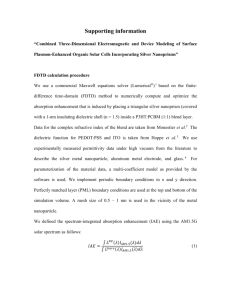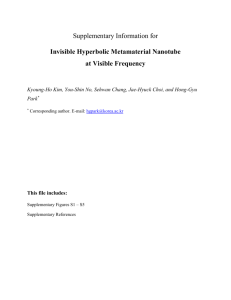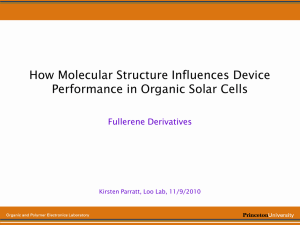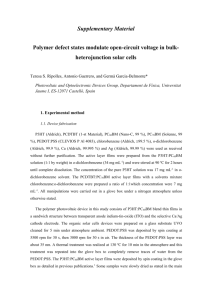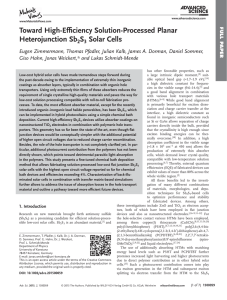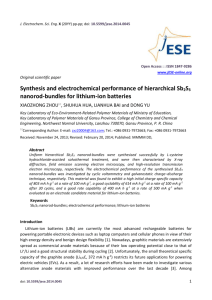Supplemental-Light-coupling-DLIP-TiO2-1.6
advertisement
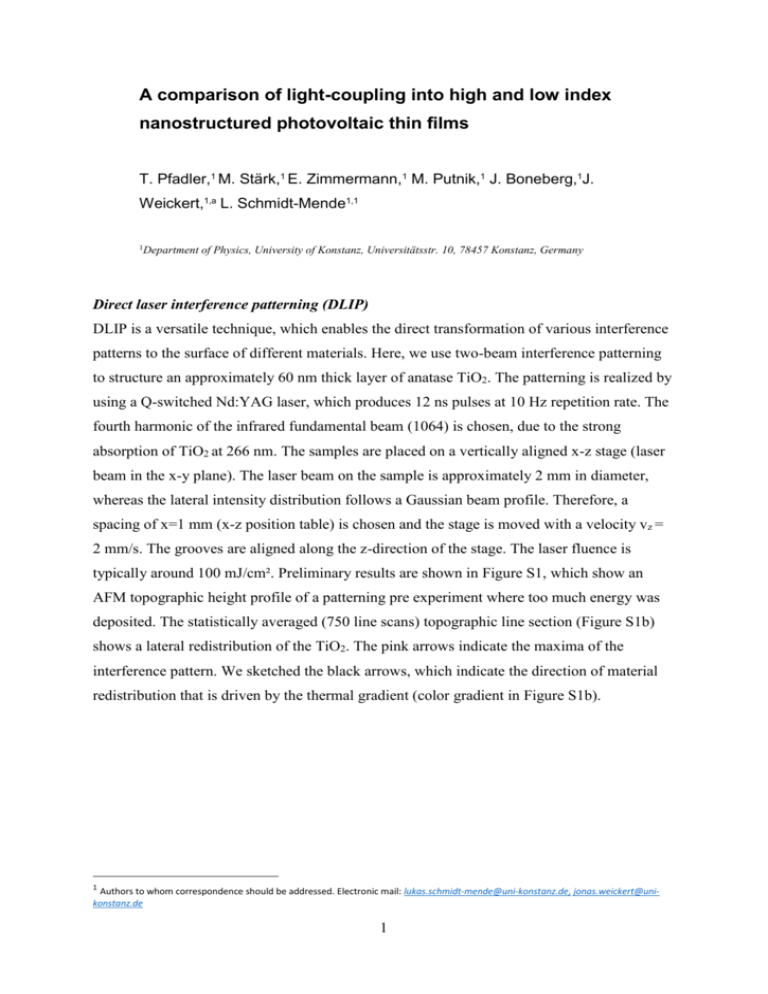
A comparison of light-coupling into high and low index nanostructured photovoltaic thin films T. Pfadler,1 M. Stärk,1 E. Zimmermann,1 M. Putnik,1 J. Boneberg,1J. Weickert,1,a L. Schmidt-Mende1,1 1Department of Physics, University of Konstanz, Universitätsstr. 10, 78457 Konstanz, Germany Direct laser interference patterning (DLIP) DLIP is a versatile technique, which enables the direct transformation of various interference patterns to the surface of different materials. Here, we use two-beam interference patterning to structure an approximately 60 nm thick layer of anatase TiO2. The patterning is realized by using a Q-switched Nd:YAG laser, which produces 12 ns pulses at 10 Hz repetition rate. The fourth harmonic of the infrared fundamental beam (1064) is chosen, due to the strong absorption of TiO2 at 266 nm. The samples are placed on a vertically aligned x-z stage (laser beam in the x-y plane). The laser beam on the sample is approximately 2 mm in diameter, whereas the lateral intensity distribution follows a Gaussian beam profile. Therefore, a spacing of x=1 mm (x-z position table) is chosen and the stage is moved with a velocity vz = 2 mm/s. The grooves are aligned along the z-direction of the stage. The laser fluence is typically around 100 mJ/cm². Preliminary results are shown in Figure S1, which show an AFM topographic height profile of a patterning pre experiment where too much energy was deposited. The statistically averaged (750 line scans) topographic line section (Figure S1b) shows a lateral redistribution of the TiO2. The pink arrows indicate the maxima of the interference pattern. We sketched the black arrows, which indicate the direction of material redistribution that is driven by the thermal gradient (color gradient in Figure S1b). 1 Authors to whom correspondence should be addressed. Electronic mail: lukas.schmidt-mende@uni-konstanz.de, jonas.weickert@unikonstanz.de 1 FIG. S1: (a) AFM topographic height profile of laser structured TiO2 where too much energy was deposited. (b) The shown profile is statistically averaged over 750 AFM line scans. The pink arrows indicate the maxima of the interference pattern, whereas the black arrows indicate the direction of lateral material redistribution. The former flat surface line is sketched (dashed line) as a guide for the eye 2 Simulated electric-field and absorption profiles of flat Sb2S3 and P3HT:PCBM Simulations of electric-field profiles and corresponding absorption within our device configuration were done with a Transfer Matrix Optical Modeling Script by Burkhard et al.[1] (downloaded from http://web.stanford.edu/group/mcgehee/transfermatrix/). Field patterns have been calculated for wavelengths between 450 and 800 nm, and the lattice point distance for calculation of the electric field was taken as 1 nm. Dispersion relations of refractive indices and extinction coefficients of ITO, PEDOT, P3HT:PCBM and silver have been taken from the database attached to the simulation program package. Values of anatase TiO2 by E. F. Schubert [2] were downloaded from http://homepages.rpi.edu/~schubert/, and values for Sb2S3 and P3HT have been measured by VASE Ellipsometry. Note, the optical data employed in Figure 3 was determined in-house following the VASE procedure described below. FIG. S2: Simulated electric field a) and absorption b) in the device configuration glass/ITO(180 nm)/TiO2(75 nm)/Sb2S3(50 nm)/P3HT(30 nm)/Ag(150 nm). FIG. S3: Simulated electric field a) and absorption b) in the device configuration glass/ITO(180 nm)/TiO2(75 nm)/P3HT:PCBM(125 nm)/PEDOT:PSS(5 nm)/Ag(150 nm). Vase Ellipsometry Wavelength dependent n and k values for the different materials (Sb2S3, P3HT: PCBM, TiO2; deposited on Si [100]) were measured by VASE Ellipsometry on a Nanofilm Ellipsometer Version EP3. The optical parameters, Ψ and Δ, were obtained for 60° to 80° angle of incident and for wavelengths between 400 nm and 880 nm. The n and k values were batch-fitted to a Fresnel model with a fixed layer thickness. The layer thicknesses were obtained beforehand by AFM measurements. All fits have small RMSE (< 5) and the absolute deviation for n and k is 2%, respectively. FIG. S4: Spectroscopic ellipsometry is employed to determine the extinction k of pure Sb2S3, TiO2, and P3HT:PCBM, respectively. Fresnel equations The obtained n values are used to plot the dispersive reflectivity R (on a logarithmic scale) based on Fresnel equations. 𝑅 = |𝑟|², where r is denoted as the reflection coefficient, 𝑛 (𝜆) 𝑐𝑜𝑠𝜃 −𝑛 (𝜆) 𝑐𝑜𝑠𝜃 r = 𝑛1 (𝜆) 𝑐𝑜𝑠𝜃𝑖𝑛+𝑛2(𝜆) 𝑐𝑜𝑠𝜃𝑡 ; 1 𝑖𝑛 2 𝑡 𝑛 𝜃𝑡 = arcsin [𝑛1 sin𝜃𝑖𝑛 ] (transmitted beam derived from Snell`s law) 2 (S1a) (S1b) where n1 = n(TiO2) and n2 is either n(P3HT:PCBM) (Figure 3b) or n(Sb2S3) (Figure 3c) and the angle of the incident 𝜃𝑖𝑛 is varied between 0° and 90°. ` UV-VIS-NIR measurements Total absorption measurements were performed via total reflection at the backport of an integrating sphere (150 mm diameter). The substrate size is (14 mm)2 but a shadow mask defines the illuminated area to be 0.5 cm². The spectroscopy system is a double-beam (sample and reference beam) CARY 5000 UV-VIS-NIR. Samples are masked, the default zero/baseline (white reflectance standard) correction is applied and the minimum in absorption for each spectra is linearly downshifted to zero absorption, respectively. Sample preparation TiO2 deposition: ITO substrates (PGO, 10 Ω □−1) were cleaned by ultrasonic bath using deionized water with dishwashing detergent, acetone and isopropanol for at least 5 min each followed by 7 min O2 plasma cleaning (Diener Femto). Approximately 60 nm of TiO2 was deposited via spray pyrolysis of a titanium diisopropoxy bisacetonate precursor (Sigma Aldrich) solution diluted 1:10 (vol:vol) in ethanol. Clean substrates were heated to 450 °C with a ramp rate of 30 °C/min. The precursor solution was then deposited using a spray nozzle, annealed at 450 °C for 15 min, and slowly cooled to room temperature over a time of approximately 2h. DLIP was then directly applied on approximately 60 nm thick anatase TiO2 films. A second approximately 15 nm thick TiO2 layer is deposited (according to the above described procedure) on the patterned as well as the flat reference devices. Organic active material system: A layer of approximately 125 nm of the P3HT: PCBM blend (1:0.8) was spincoated (1 min/ 1000 rpm) on clean glass/ITO/TiO2 substrates. P3HT was purchased from Merck and PCBM from Nano-C. An electron blocking layer of 5-10 nm PEDOT:PSS is deposited on top following the procedure of Weickert et al.[3] 150 nm Ag are thermally evaporated (Theva evaporation system) as backreflector (backelectrode) on top. Devices are finally thermally annealed (10 min, 140 ° C) in a nitrogen filled glove box. In-organic active material system: The approximately 50 nm thick Sb2S3 layer is prepared by chemical bath deposition (CBD) according to a previously reported procedure with minor adjustments.[4] In particular, solutions of Na2S2O3 (4 g) in deionized water (25 ml) and SbCl3 (650 mg) in acetone (2.5 ml) were prepared and cooled in an ice bath for 90 min. Precursors were mixed into 100 ml of likewise cooled deionized water and samples are immediately put into the mixed solution. After chemical bath deposition samples were rinsed with deionized water and promptly dried in a nitrogen stream. Subsequently, the coated backside of the samples was cleaned with hydrochloric acid, and the samples were annealed at 300 °C for 35 min in a nitrogen atmosphere. P3HT solution (10 mg/ml in chlorobenzene (CB)) was then spin-coated at 1500 rpm for 1 min to obtain an approximately 30 nm thick film. As backcontact, 150 nm Ag was deposited via thermal evaporation. 1. 2. 3. 4. Burkhard, G.F., E.T. Hoke, and M.D. McGehee, Accounting for interference, scattering, and electrode absorption to make accurate internal quantum efficiency measurements in organic and other thin solar cells. Advanced Materials, 2010. 22(30): p. 3293-7. Schubert, E.F. Refractive index and extinction coefficient of Materials. 2004 [cited 2014 Oct]; Available from: http://homepages.rpi.edu/~schubert/Educationalresources/Materials-Refractive-index-and-extinction-coefficient.pdf. Weickert, J., et al., Spray-deposited PEDOT:PSS for inverted organic solar cells. Solar Energy Materials and Solar Cells, 2010. 94(12): p. 2371-2374. Messina, S., M.T.S. Nair, and P.K. Nair, Antimony sulfide thin films in chemically deposited thin film photovoltaic cells. Thin Solid Films, 2007. 515(15): p. 5777-5782.
